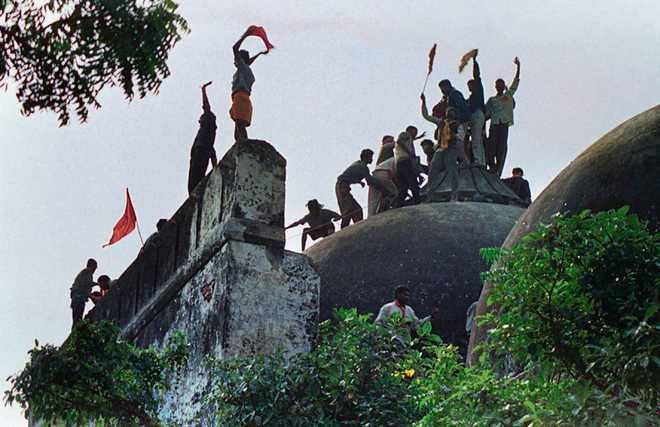BJP’s compassion for Narasimha Rao
Rasheed Kidwai
Senior journalist
Had PV Narasimha Rao lived on (he would have turned 98 on June 28), he would have allowed himself a chuckle in the wake of Prime Minister Narendra Modi’s outpouring of sympathy for him.
Speaking in the Lok Sabha on the motion of thanks on the President’s address on Tuesday, Modi attacked the Congress, questioning the party’s regard towards former PM Narasimha Rao. Modi said, “Did they (Congress) ever speak about good work of PV Narasimha Rao ji?”
The BJP Prime Minister’s compassion towards Rao was interesting as during the course of his speech, Modi went on to make another revelation of sorts. Modi, while accusing the Congress of missing many opportunities to bring gender justice, quoted a minister in the Rajiv Gandhi Cabinet as saying that it was not their duty to uplift the Muslims if the community wanted to live in a ‘gutter’.
Hours later, Arif Mohammad Khan, who served as a junior minister in the Rajiv Cabinet, named Narasimha Rao as the one who had made that ‘gutter’ comment. On his part, Khan defended Modi for exposing the Congress doublespeak and lack of sincerity towards the Muslims. But in effect, Modi and Khan reinforce the views of a section of the Congress that Rao’s Machiavellian deeds were responsible for his ill-treatment.
Rao himself remained a staunch Congressman throughout his career spread over six decades. He died eight months after the Sonia Gandhi-led UPA came to power in 2004. During those days of isolation, illness and facing indignity, Rao held the BJP responsible for destroying his otherwise impressive political career, including being the architect of economic reforms. In his book Ayodhya 6 December 1992, Rao argued on a singular point — the BJP had aborted the Ayodhya solution.
Known to measure words, the late Prime Minister wrote that the BJP scuppered a possible solution to the temple dispute to keep the Ayodhya pot boiling. Till August 1992, Rao observed that his talks with ‘apolitical’ sadhus and sanyasis on how and where a Ram temple could be built in Ayodhya “without breaking the law or upsetting communal harmony” were proceeding quite well. Then, abruptly, the VHP-backed sadhus broke off the talks. Four months later, the 16th century mosque was demolished by hordes of kar sevaks.
“Why did they (the sadhus) go back on their promise (to explore all avenues towards a peaceful settlement of the dispute),” Rao wondered in his book and then offered a plausible explanation: “It was clear that there was a change of mind on their (the sadhus’) part, or what is more likely, on the part of the political forces that controlled them. Without naming the BJP, Rao penned, “These forces deliberately wanted to get out of (a) friendly situation which the sanyasis were getting into with me and which, if left to itself, would have made the mandir issue wholly apolitical,” and added, “This subtle aspect of the Ram Janmabhoomi matter is very important and brings home the undeniable fact that while Hindu masses were swayed by their devotion to Ram and their intense desire for the temple, the political forces behind the issue could not care less for the temple — they only wanted to retain a long-term, vote-rich communal issue for as long as they could.”
Old-timers would recall that until August 1992, Rao had been in constant touch with the top Rashtriya Swayamsevak Sangh leadership at Nagpur to try and resolve the Ayodhya dispute amicably. Congress leaders such as VN Gadgil and Vasant Sathe had acted as his personal emissaries. Several sadhus and sants of that era, namely Mahant Avaidyanath, Vamdeoji Maharaj, Ramchandradas Paramhans, Mahant Nrityagopal Das, Swami Paramanandji, Swami Chinmayananda and Pejawar Swamiji used to regularly visit 7, Race Course Road, New Delhi, which was Rao’s prime-ministerial residence. The then Prime Minister had also sought the help of many apolitical saints, such as Jain Muni Acharya Sushil and his spiritual guru based in Ramtek (Maharashtra), to prevail upon the Sangh-Vishwa Hindu Parishad to go slow on Ayodhya.
If Prime Minister Modi and other BJP leaders care to go through Rao’s book on the Ayodhya dispute, they will find several references revealing the former Prime Minister’s reading of the BJP and Sangh Parivar. In his book, Rao argued that a political group’s ‘majority communal orientation’ and its need to keep Ayodhya as a ‘permanent, evergreen issue’ led it to scuttle the possibility of an out-of-court settlement before December 6, 1992.
According to Rao, the demand for the Ram temple in Ayodhya was not for just one temple. “More had been lined up, so that the agitation could be kept alive even if the issues of one or two specific temples were settled. The number was three (Ayodhya, Mathura, Kashi) and for good measure, in the unlikely event of all three temple issues being settled amicably (unfortunately for them), there was a never-ending store of more than 3,000 controversial temples lined up all over the country!” Rao wrote.
The former Prime Minister also observed that when he discussed these issues with his Congress party colleagues in the Cabinet, they were not helpful. “It was me that they demolished,” Rao rued, projecting himself as a scapegoat of sorts.
Interestingly, when the Babri Masjid fell on December 6, 1992, Rao found himself isolated in the Cabinet meeting that took place in the evening of that fateful day. Manmohan Singh, who had taken over as Finance Minister, tried to stand by Rao. Nehru-Gandhi family retainer ML Fotedar, who was Union Health and Family Welfare Minister then, is said to have chided Manmohan for backing Rao. “I told him (Manmohan), ‘Kindly keep quiet’...,” Fotedar had told an interviewer later.










